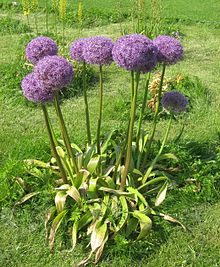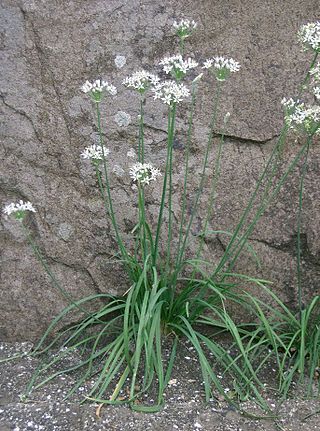
Allium tuberosum is a species of plant native to the Chinese province of Shanxi, and cultivated and naturalized elsewhere in Asia and around the world.
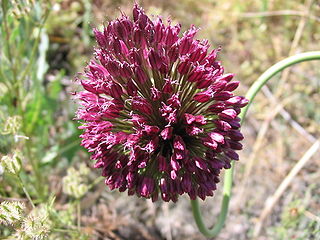
Allium sphaerocephalon is a plant species in the Amaryllis family known as round-headed leek, round-headed garlic, ball-head onion, and other variations on these names. Drumstick allium is another common name applied to this species. Some publications use the alternate spelling Allium sphaerocephalum. It is a bulbous herbaceous perennial plant.

Allium nigrum, common name black garlic, broad-leaved leek, or broadleaf garlic, is a Middle Eastern species of wild onion. It lacks the onion or garlic scent shared by most of the other species in the group. The species is native to Turkey, Cyprus, Syria, Lebanon, and Israel but cultivated as an ornamental in many other places. It has become naturalized in some regions, including parts of the United States.

Allium stipitatum, Persian shallot, is an Asian species of onion native to central and southwestern Asia.

Allium siculum, known as honey garlic, Sicilian honey lily, Sicilian honey garlic, or Mediterranean bells, is a European and Turkish species of plant in the genus Allium. It is native to the regions around the Mediterranean and Black Seas, and grown in other regions as an ornamental and as a culinary herb.
Allium tschimganicum is a Central Asian species of onion native to Uzbekistan and Kyrgyzstan. The Flora of China regards this name as synonymous with Allium fetisowiiRegel. However, other sources accept A. tschimganicum as a distinct species.
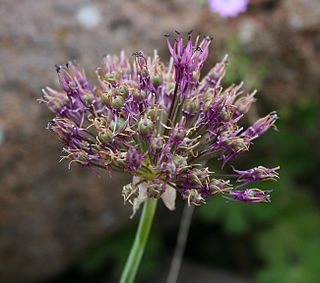
Allium cyrilli is a plant species native to Greece, Turkey, and to the Apulia region of southeastern Italy.
Allium decipiens is a Eurasian species of garlic in the amaryllis family native to eastern Europe and western Asia.
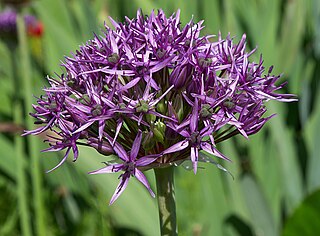
Allium atropurpureum is a plant species native to Hungary, the Balkans, and Turkey. It is widely grown as an ornamental for its rich, deep purple flowers.
Allium elmaliense is a species of onion endemic to Antalya Province in southwestern Turkey. It has spherical to egg-shaped bulbs up to 3 cm in diameter. Stipe is up to 30 cm tall. Flowers are fragrant; tepals are white with green midveins.
Allium basalticum is a plant species found in Israel, Jordan, and Lebanon, and formerly considered under Allium nigrum. Bulbs are egg-shaped, up to 30 mm long. Scape is straight, round in cross-section, up to 60 cm tall. Leaves are narrowly lanceolate, up to 50 cm long. Tepals are white with conspicuous green midveins; anthers yellow; ovary deep purple at flowering time, later turning green.
Allium israeliticum is a species of onion native to Israel, Palestine and Jordan. Bulbs are egg-shaped, up to 30 mm long. Scape is flexuous, up to 40 cm long. Leaves are thick, recurved, up to 30 cm long, tapering toward the tip. Tepals are translucent white with green midveins; anthers yellow; ovary green.
Allium dumetorum is a Middle Eastern species of onion found in Israel, Palestine, Lebanon and Jordan. It is a bulb-forming perennial with a few pinkish flowers; ovary pale green.
Allium lachnophyllum is a species of wild onion native to Israel and Palestine. It is a bulb-forming perennial that produces an umbel of flowers.
Allium materculae is a species of onion native to Turkey, Iran, and Russia.

Allium is a genus of monocotyledonous flowering plants with hundreds of species, including the cultivated onion, garlic, scallion, shallot, leek, and chives. The generic name Allium is the Latin word for garlic, and the type species for the genus is Allium sativum which means "cultivated garlic".
The precise taxonomy of the genus Allium is still poorly understood with incorrect descriptions being widespread. With over 850 species distributed over the Northern hemisphere Allium is the sole genus in the Allieae, one of four tribes of subfamily Allioideae (Amaryllidaceae). New species continue to be described and Allium is both highly variable and one of the largest monocotyledonous genera, but the precise taxonomy of Allium is poorly understood, with incorrect descriptions being widespread. The difficulties arise from the fact that the genus displays considerable polymorphism and has adapted to a wide variety of habitats. Furthermore, traditional classications had been based on homoplasious characteristics. However, the genus has been shown to be monophyletic, containing three major clades, although some proposed subgenera are not. Some progress is being made using molecular phylogenetic methods, and the internal transcribed spacer (ITS) region, including the 5.8S rDNA and the two spacers ITS1 and ITS2, is one of the more commonly used markers in the study of the differentiation of the Allium species.
Allium bisotunense is a species of flowering plant in the family Amaryllidaceae and is endemic to Iran.

Allium suworowii is a species of onion native to Afghanistan and Central Asia. It is a widely distributed and highly genetically variable species. It has gained the Royal Horticultural Society's Award of Garden Merit as an ornamental.

Allium orientale is a species of wild garlic/onion native to the eastern Mediterranean; Libya, Egypt, Sinai, the Levant, Cyprus and Anatolia. It has high genetic variation but is not widely distributed, suggesting that it may contain cryptic species.
